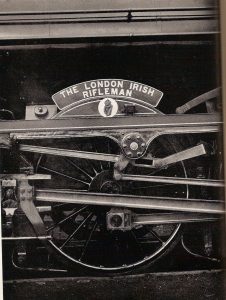 During a recent review of the LIR archives, we came across this rather excellent photograph of a steam engine nameplate that was included in the LIR’s 100th anniversary commemorative booklet published in 1959.
During a recent review of the LIR archives, we came across this rather excellent photograph of a steam engine nameplate that was included in the LIR’s 100th anniversary commemorative booklet published in 1959.
When we contacted the National Railway Museum at York this week, they told us:
“The nameplate “London Irish Rifleman”, was attached to a Royal Scot Class locomotive of the London, Midland & Scottish (LMS) Railway. No. 6138 was built at the North British Locomotive Works, Glasgow and delivered to the LMS in 1927.
Originally named “Fury” after a famous locomotive of the London & North Western Railway (a constituent company of the LMS), the decision was taken to rename it in line with the policy of naming this type of locomotive after regiments of the British Army that had a connection with the LMS region, and in October 1929 the engine was renamed “London Irish Rifleman”.
The engine was largely based in the North West of England and North Wales, but was occasionally used to cover services run from London and Aberdeen. At the nationalisation of the railways following the Second World War, the locomotive was renumbered 46138 and remained in service until early 1963.
The engine was scrapped at Crewe in May 1963 having travelled approximately 2.5 million miles during its working life.
Unfortunately, I am unable to tell you where the nameplates now are or even if they survive.”
We note the mileage of the engine, which may seem a quite familiar figure for both our Veterans and current serving Riflemen.
STOP PRESS.
“Further to the previous information, we can confirm that at least one of the nameplates for this locomotive survived but unfortunately we cannot confirm its whereabouts. The book “Nameplates on Display” by Ian Wright (Pennine Publications 1986) lists a nameplate and its associated regimental badge as being on display at the ‘Big Four’ Railway Museum in Bournemouth. The museum hosted the nameplate collection of Frank Burridge, a railway enthusiast, collector and author who had acquired a sizeable collection of nameplates. Unfortunately the museum shut many years ago and the nameplate collection was sold off, mainly to private buyers.
However there would have been two nameplates on the engine originally, one on each side, so there may actually be two plates out there somewhere. When BR was scrapping engines in the 1960s plates were often offered/presented to any organisations they were named after and I understand a number of the Royal Scot class regimental nameplates are in the hands of the relevant regimental museums as a consequence of this. However BR was also selling plates for relatively small amounts of money to interested enthusiasts and collectors who approached them so the plates are often still in private ownership.”